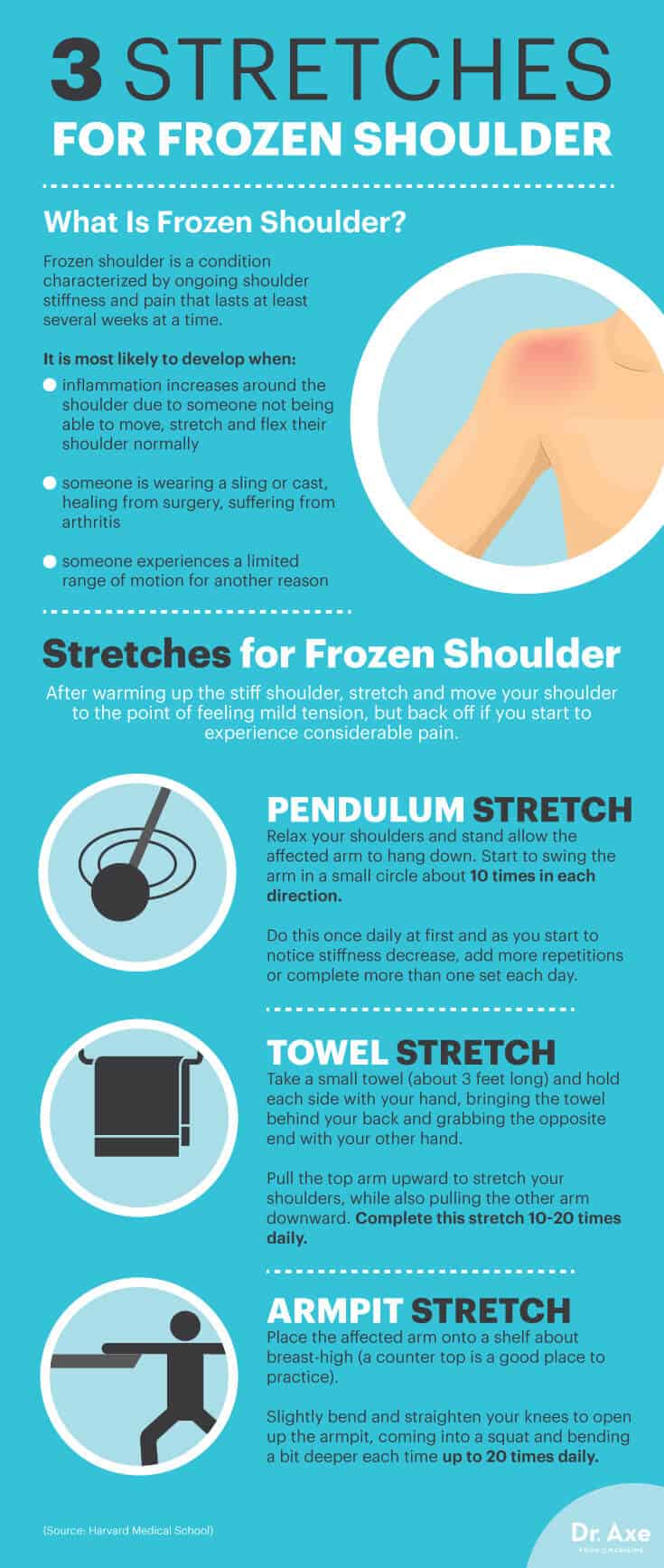This Dr. Axe content is medically reviewed or fact checked to ensure factually accurate information.
With strict editorial sourcing guidelines, we only link to academic research institutions, reputable media sites and, when research is available, medically peer-reviewed studies. Note that the numbers in parentheses (1, 2, etc.) are clickable links to these studies.
The information in our articles is NOT intended to replace a one-on-one relationship with a qualified health care professional and is not intended as medical advice.
This article is based on scientific evidence, written by experts and fact checked by our trained editorial staff. Note that the numbers in parentheses (1, 2, etc.) are clickable links to medically peer-reviewed studies.
Our team includes licensed nutritionists and dietitians, certified health education specialists, as well as certified strength and conditioning specialists, personal trainers and corrective exercise specialists. Our team aims to be not only thorough with its research, but also objective and unbiased.
The information in our articles is NOT intended to replace a one-on-one relationship with a qualified health care professional and is not intended as medical advice.
Frozen Shoulder Exercises + Natural Treatment
June 13, 2017

Frozen shoulder (also referred to as adhesive capsulitis) is a condition often diagnosed when someone experiences ongoing shoulder stiffness and pain that lasts at least several weeks at a time. It’s most likely to develop when inflammation increases around the shoulder due to shoulder immobility or problems stretching and flexing the shoulder normally.
This commonly occurs when someone is recovering from an injury. Frozen shoulder sometimes occurs when someone is wearing a sling or cast, healing from surgery, suffering from arthritis or experiencing a limited range of motion for another reason, such as a result of a sedentary lifestyle.
The American Academy of Orthopedic Surgeons estimates that between 2 to 5 percent of the adult population experiences frozen shoulder at any given time. (1) Most people develop frozen shoulder in stages and experience persistent muscle or joint pain, along with stiffness, for several months or more.
It’s not uncommon for frozen shoulder to last for up to a year if left untreated, which can make it hard to exercise, sleep normally and go about other normal life activities pain-free. Usually, the longer shoulder pain persists, the more limited mobility becomes. This only tends to make frozen shoulder pain worse in the long run.
Early treatment of frozen shoulder using targeted shoulder exercises, stretches and natural anti-inflammatory applications can help control symptoms and prevent worsening stiffness. Harvard Medical School calls shoulder stretching exercises “the cornerstone of treating frozen shoulder.”
Older people, and those with other medical conditions related to high levels of inflammation (like diabetes or thyroid problems), are more likely to experience frozen shoulder, so controlling these conditions through a healthy lifestyle also helps lower the risk for injury and complications.
Frozen Shoulder Symptoms
The most common symptoms of frozen shoulder include:
- stiffness in and around the shoulder; this usually happens in one shoulder at a time (not both) and is more likely to return in the same shoulder. However, the American Physical Therapy Association reports that people who have had a frozen shoulder in one arm have about a 20 to 30 percent chance of developing it in the other arm as well. (2)
- muscle, joint and bone pain in and around the shoulders or arms
- limited range of motion
- having trouble moving and using the shoulders or arms normally (such as having trouble reaching, getting dressed, driving, holding objects in front of you, carrying things and sleeping normally) (3)
The majority frozen shoulder cases typically develop gradually, with symptoms becoming worse over several weeks or months. Doctors usually categorize frozen shoulder progression into three to four stages, each one which typically lasting 1 to 3 months and causing different levels of pain and stiffness. The symptoms of frozen shoulder depends on which stage they are in.
The Hospital For Special Surgeries in New York City categories the four stages of frozen shoulder as:
the initial “pre-freezing stage,” the “freezing stage,” the “frozen stage” and the final “thawing stage.” (4) In the freezing stage, movement of the shoulder is limited and the area around the shoulder starts causing noticeable pain. The pain can decrease during the freezing stage, but stiffness can really set in at this point and even become severe.
The frozen Stage is characterized by a stiff shoulder, but it’s no longer painful at rest. The thickness and scarring of the shoulder capsule limits range of motion and causes pain during stretching or reaching. During the final thawing stage, range of motion in the shoulder can improve, but pain might still come and go, especially at night or when putting pressure on the shoulder socket.
5 Natural Treatments for Frozen Shoulder
Some doctors choose to treat very painful cases of frozen shoulder with steroids (like corticosteroids), numbing medications or painkillers, and rarely, even arthroscopic surgery to loosen the inflamed joint capsule. When pain becomes very bad, you can use an over-the-counter painkiller temporarily (like ibuprofen) to help you heal and go about your day normally. Ultimately, though, you want to focus on resolving the underlying condition to prevent pain from returning.
A natural approach to treating frozen shoulder involves gradually improving range of motion through practicing safe and targeted exercises, stretching the shoulder, using natural pain-killing treatments, and lowering inflammation. The University of Washington Orthopedics and Sports Medicine Department reports that “most stiff shoulders can be managed successfully by a simple exercise program conducted by the patient in their own home.” (4)
1. Heat and Stretch the Shoulder
Before starting shoulder exercises for frozen shoulder, make sure to warm up your shoulder in order to boost blood supply in the affected area and prevent further injuries. Patience is key when it comes to treating a frozen shoulder, so give yourself time to heal and progress slowly. The goal is to gently, safely and progressively get the shoulder moving again, but this can sometimes take months, so don’t rush.
Some of the most effective ways to stretch and warmup the shoulder include applying heat for 10 to 15 minutes, taking a warm shower or bath (including one with Epsom salt) and starting to gently move the shoulder in small circular motions if possible. You can create your own heat pack or using a commercial heating pad.
While stretching the shoulder, you want to focus on slight tension and soreness, but not doing too much too soon. A good way to judge the intensity is to pay attention to soreness once you’re done stretching: it should go away in about 15 minutes. Make sure to relax and allow your muscles to loosen so that the stretch is being applied to soft (not tense and tight) tissue. To begin gently bringing more motion and flexibility to your stiff shoulder, try slowly practicing some of these simple shoulder stretches and movements 2 to 3 times daily:
- sit or lie down and lift your arm straight above you
- practice externally rotating the arm by opening and closing a cabinet or door
- lie down and make a “T” shape by bringing your arms outward and to the floor
2. Exercises to Improve Shoulder Mobility
After warming up the stiff shoulder and making sure to stay relaxed (deep breathing can help here), researchers from Harvard Medical School recommend you complete the following series of shoulder/arm exercises described below. (5) Stretch and move your shoulder to the point of feeling mild tension, but back off if you start to experience considerable pain. For the first couple weeks, work on improving flexibility and mobility, then you can move on to adding resistance to improve the strength of your shoulder.

- Pendulum stretch: Relax your shoulders and stand; allow the affected arm to hang down. Start to swing the arm in a small circle about 10 times in each direction. Do this once daily to start, and decrease as you start to notice stiffness. Add more repetitions or complete more than one set each day. You can also work on adding a small amount of weight (holding a 3- to 5-pound dumbbell in your hand) or increasing the diameter of your arm swing slowly. This opens the shoulder more.
- Towel stretch: Take a small towel (about 3 feet long) and hold each side with your hand, bringing the towel behind your back and grabbing the opposite end with your other hand. Pull the top arm upward to stretch your shoulders, while also pulling the other arm downward. Complete this stretch 10 to 20 times daily.
- Finger walk: Stand in front of a wall with your fingertips on the wall at waist level, keeping your arm slightly bent. Slowly walk your fingers up the wall, working on lengthening the arm upward as far as you comfortably can. Repeat from the beginning and perform 10 to 20 times a day.
- Cross-body reach: Use your good arm to lift your affected arm at the elbow, and bring it up and across your body so you can hold a stretch in the whole arm for 15 to 20 seconds. Do this 10 to 20 times per day, working on reaching further across your body as mobility increases.
- Armpit stretch: Place the affected arm onto a shelf about breast-high (a counter top is a good place to practice). Slightly bend and straighten your knees to open up the armpit, coming into a squat and bending a bit deeper each time, up to 20 times daily.
- Outward and inward rotation: These strengthening and rotation exercises use added resistance and should be done once mobility is improving and pain is decreasing. Make sure you warm up and stretch the affected shoulder first. For outward rotation and strength, hold a rubber exercise band between your hands and rotate the lower part of the affected arm outward 15 to 20 times. For inward rotation, hook one end of a rubber exercise band around a doorknob and pull the band toward your body 15 to 20 times daily.
3. Physical Therapy
While these exercises described above are simple enough to perform at home, if pain continues and makes it hard to move around or work normally, see a physical therapist who can assign specific exercises and stretches to improve your range of motion, strength and flexibility. For some people, 4 to 12 weeks of physical therapy is necessary to overcome frozen surgery, at which point range of motion usually returns to normal.
4. Numbing Pain Naturally
As you’ve probably gathered by now, continuing to move your frozen shoulder gradually is the key to treating the condition. However, this can cause some pain and discomfort. Rather than relying on drugs, you can help control pain naturally with holistic homemade treatments for frozen shoulder such as essential oils and other muscle relaxers.
Try using peppermint oil on your affected shoulder to boost circulation, reduce inflammation and reduce pain. Massage therapy, physical therapy, magnesium cream and acupuncture might also help control swelling and improve range of motion.
5. Lowering Inflammation & Preventing Complications
To help control inflammation long-term and prevent injuries from reoccurring, focus on eating a healing diet and taking anti-inflammatory supplements that aid in improving recovery. Anti-inflammatory supplements and herbs include: turmeric, omega-3 fatty acids, magnesium and CoQ10.
Foods that help fight inflammation include all sorts of fresh veggies and fruit, probiotic-rich foods (yogurt, kombucha, kefir and cultured veggies), grass-fed beef, wild-caught fish, cage-free eggs and healthy fats like nuts, seeds, avocado, coconut and olive oil. Try to also limit other factors that contribute to inflammation, such as high levels of mental stress, being overweight or obese, sitting for long periods, cigarette smoking, chemical or toxin exposure, and high amounts of exposure to vibration from vehicles (for example, being a truck driver for a living).
What Causes Frozen Shoulder?
Risk factors for developing frozen shoulder include: (6)
- being over the age of 40; frozen shoulder affects people between 40 and 70 most often
- healing from an injury or surgery that limits normal range of motion of the shoulder and arm
- having hormonal imbalances, including a thyroid disorder or recently going through menopause
- being a woman; researchers estimate that up to 70 percent of adults with frozen shoulder are women. (8) Researchers believe that hormonal imbalances are one reason why more women experience frozen shoulder than men
- recovering from a stroke or cervical disc disease that affects the nerves around the shoulder
- not moving your arm due to other pain or injuries (such as arthritis, a rotator cuff tear, bursitis or tendonitis)
- having a pre-existing inflammatory medical condition, including heart disease or diabetes
- recently undergoing open heart surgery or spinal surgery
- having high levels of inflammation, due to factors like eating a poor diet and living a sedentary lifestyle
Frozen shoulder is caused by a lack of movement and flexibility around the shoulder, along with inflammation of the shoulder capsule, joints and ligaments. The “capsule” of the shoulder joint contains ligaments that hold the shoulder bones together and help with normal motion and movement, but the capsule can become inflamed due to injury, overuse, surgery or for other reasons that impair the shoulder bones’ ability to glide within the joints. As the shoulder capsule thickens and tightens, it constricts the joints of the shoulder joint even more and makes movement very painful. (8)
Because inflammation associated with frozen shoulder starts out by causing pain, it usually results less movement. This kicks off a downward spiral, contributing to less movement and even more stiffness. In this way, unfortunately, frozen shoulder sometimes become a vicious cycle: initial pain and reduced mobility causes stiffness, which only causes further reduced mobility and pain. This is exactly why stretching and exercising the frozen shoulder helps prevent and resolve the condition.
Frozen Shoulder vs. Bursitis: What’s the Difference?
Bursitis is another inflammatory condition affects the shoulders and causes similar symptoms to frozen shoulder. However, bursitis is not limited to the shoulders and can also affect any of the small, fluid-filled sacs (bursae) located in between bones, tendons and joints. Bursae normally act like natural cushions between the bones and help with shock-absorption and movement, but they can sometimes become inflamed and cause pain in the process, especially in joints of the shoulders, knees, elbows and hips.
Older people, those with rheumatoid arthritis, gout symptoms or diabetes are most likely to have bursitis. (9) It’s also most common to develop bursitis around joints that perform frequent repetitive motions, and shoulders certainly fall into this category. Shoulders are one of the most overused and susceptible body parts when it comes to injuries and inflammation.
If your job requires you to lift heavy objects and use your shoulders or arms frequently, or you play sports or enjoy hobbies that put stress on your shoulders (such as playing tennis, gardening, playing an instrument, golfing or playing basketball), than you’re more likely to develop inflammatory muscle aches and joint pains including bursitis or frozen shoulder at some point.
Treatment for bursitis and frozen shoulder are mostly the same and focus on taking pressure off the shoulder joints and bones, resting the area, reducing inflammation and giving yourself a break from strenuous activities and repetitive shoulder movements. These steps help protect the shoulder from further trauma or damage, and within a few weeks pain and stiffness usually subside.
Staying Active: Exercise Following a Frozen Shoulder
After several weeks or months of stretching and exercising the frozen shoulder, you can likely return to exercising more formally. It’s always a good idea to check with your doctor before resuming exercise, and even once you return to normal activities, make sure to keep an eye on your symptoms and pain. To get the most benefits from exercise, always make sure to warm up, stretch and cool down, and lower your intensity if you notice shoulder pain returning.
Experiencing a frozen shoulder might deter you away from exercising or keeping up with hobbies you enjoy, but remember that a sedentary lifestyle and immobilization of the arms is one of the leading causes of frozen shoulders in the first place. (10) Regular exercise actually helps keep your joints supple and prevents injuries when done safely. Exercise has a natural “lubricating” effect on joints and tissue, plus it moves lymphatic system fluid through your body and boosts immune function — which is why the saying goes “if you don’t use it, you lose it!”
When the time is right, try returning to formal exercise and focus on also getting aerobic exercise each day. Brisk walking, jogging or running, cycling, circuit training or burst training, swimming, water aerobics and climbing stairs are good ways to keep inflammation down, improve circulation and fight the effects of aging.
Final Thoughts
Frozen shoulder is also called adhesive capsulitis and is often caused by a lack of movement and flexibility problems around the shoulder. This common condition generally only affects on shoulder at a time and develops gradually. Hallmark symptoms include shoulder stiffness, along with muscle, bone and joint pain in the shoulder. Limited range of motion and trouble moving through a normal range of motion are also common symptoms.
Since lack of movement is a common cause, people recovering from certain injuries, broken bones or surgeries are at a particular risk for frozen shoulder, although inflammatory conditions and hormone imbalances also play a role, particularly among women.
Luckily, specific stretches and gentle exercises are very effective in treating frozen shoulder, although physical therapy is sometimes required when at-home care doesn’t work.














